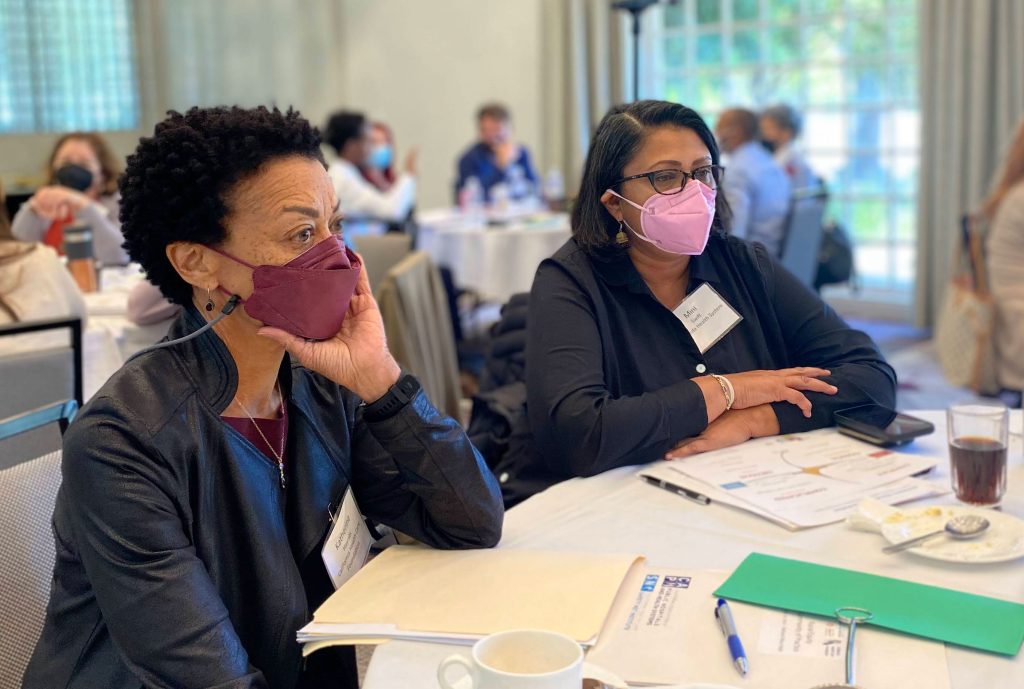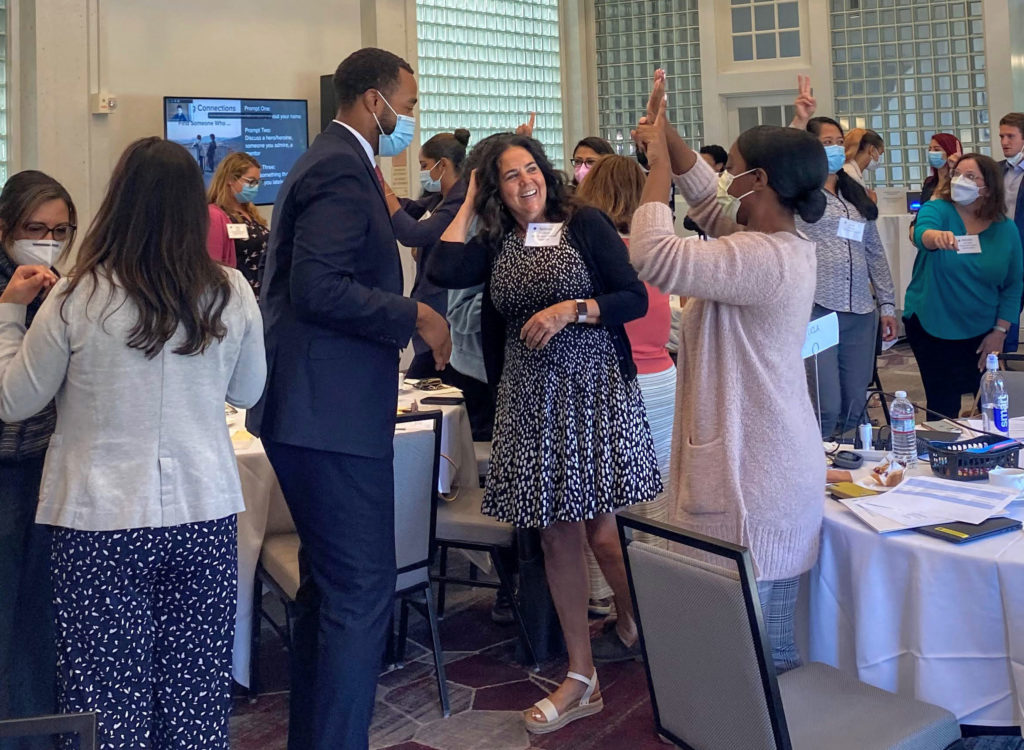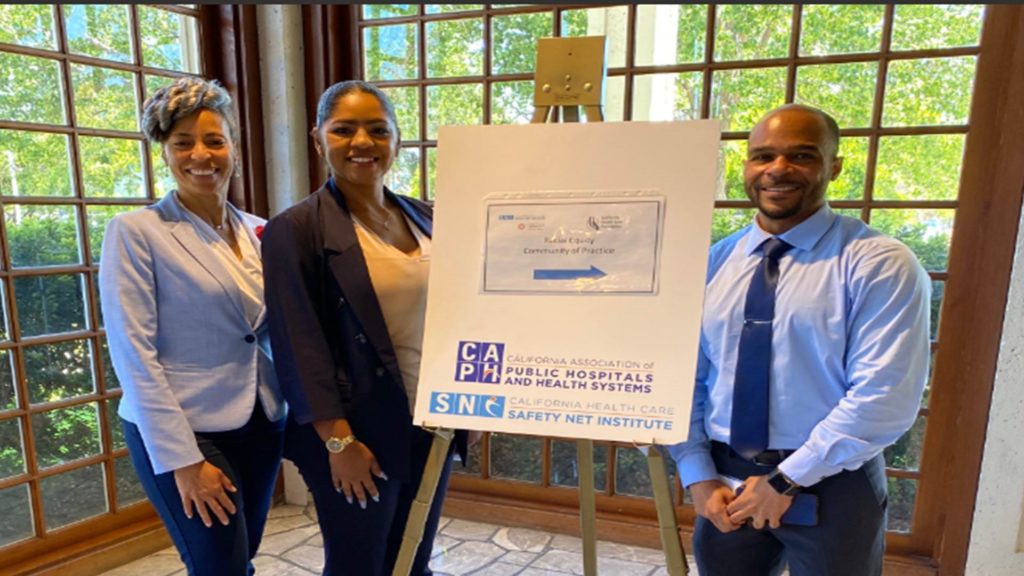Article by: Aisling Carroll

CAPH is posting this on behalf of our partner organization the California Health Care Safety Net Institute.
The evolution of Alameda Health System’s equity journey, and the support of peers
“We have experience addressing disparity gaps in some areas, such as our BElovedBIRTH Black Centering program,” said Dr. Mini Swift, vice president of population health, Alameda Health System (AHS). “But what we need to do is center equity in operations and figure out how do we have – at the organizational level – dedicated resources and strategy so all patients receive equitable care?”
Together, Swift and 70 of her safety net peers across 12 California public health care systems grapple with these types of complex questions as the Racial Equity Community of Practice (CoP). Gathering virtually and in person since early 2022, they have been delving into how to bolster their efforts to dismantle structural racism and improve health equity within their organizations. CoP is a program of the California Health Care Safety Net Institute (SNI) and funded by the California Health Care Foundation.
Comprising more than half of the state’s safety net providers, these systems predominantly serve communities of color and historically marginalized groups. For years, many have rolled out a range of programs and policies to uproot structures driving health inequities for patients and a lack of diversity, inclusion, and belonging among staff.
CoP’s peer-to-peer sharing allows participants to “understand the journeys, the pains, and the successes that other systems have had in their equity work, and what they would do differently.”
– Giovanna Giuliani
To help accelerate these systems’ equity efforts in the wake of the disproportionate impact of the COVID-19 pandemic on racial and ethnic groups and the unrest of 2020 after George Floyd’s murder, SNI formed CoP in early 2022. This 18-month learning and problem-solving collaborative aims to improve health care that more people of color across the state can trust.
“We’re talking about undoing 400 years of scientific medicine’s history of validating racism, and that’s our responsibility in this room, and that’s why it takes so much,” said Mikel Whittier, director of health equity, diversity and inclusion, UCLA Health, at a gathering with his CoP peers in July 2022.
CoP’s peer-to-peer sharing allows participants to “understand the journeys, the pains, and the successes that other systems have had in their equity work, and what they would do differently,” said Giovanna Giuliani, executive director, SNI. This hard-won knowledge, coupled with a deep commitment to each other’s progress, might help systems prevent missteps, spur faster advancements, and ultimately achieve equity excellence for their patients, staff, and community.
Centering anti-racism at the core of quality
Since its founding in 1864, AHS has been an advocate for equitable health care. Operating four hospitals, four post-acute sites, and four wellness centers across Alameda County, the system has been called a wellspring of Black physician leadership that has deep ties to the broader community, which is Latino (35%), Black (27%), and Asian (14%).
Swift says she’s never had to explain why equity matters to AHS’s leadership team, but she can wrestle with explaining to others the rationale behind placing equity at the core of quality care, which is made up of five other domains.
“We are familiar with the six pillars of quality: patient centered, equitable, evidence based, safe, cost effective, and timely. I’m asking people to consider how we can center anti-racism at the core of quality and operationalize it in how we deliver health care.”
In what Swift called “a profound moment” during a CoP session in July 2022, she listened to Hugh Vasquez, senior associate at the National Equity Project and CoP’s equity expert, articulate why equity should be a central measure of quality in crystal clear terms. Swift immediately wrote his words down: “Designing without centering equity is guaranteed to reproduce the very structures that we’re trying to dismantle.”
The next day, buoyed by how the quote summarized the imperative for centering equity into operations, Swift shared it with 165 managers at a monthly meeting. Arleen Gomez, director of organizational learning and effectiveness, AHS, and co-chair of the health equity, diversity and inclusion (HEDI) committee with Swift, was also moved to discuss it with the Board of Trustees HR subcommittee.
Since Swift oversaw the formation of AHS’s first equity council in 2009, she has been working closely with Gomez and other passionate colleagues to chip away at an array of structures and barriers that impede equity.
Both Swift and Gomez believed the quote could help them increase understanding, invite discussion, and create consensus to advance AHS’s equity-related work. It was the perfect message at the perfect time for AHS because it coincided with the organization’s development of a new strategic plan.

AHS’ struggles, wins, and work underway
“We provide equal care but not equitable care across the board. And that’s the challenge we are tackling,” said Mark Fratzke, chief operating officer, AHS, who favors navigating this road with trusted CoP peers who support each other.
Achieving equitable care requires everyone having the opportunities and resources they need to reach their highest level of health. Since Swift oversaw the formation of AHS’s first equity council in 2009, she has been working closely with Gomez and other passionate colleagues to chip away at an array of structures and barriers that impede equity.
In a grassroots manner, staff at AHS has collaborated internally and with patients, community members, and Alameda County to help design and provide equity programs and policies: HealthPATH, a health care training program that provides internships to students from the Alameda County communities most impacted by health inequities; BElovedBIRTH Black Centering program; the Homeless Health Center and a mobile clinic; and the “food farmacy,” to name a few. In the July CoP session, Swift shared this years-long, organic journey with her peers in hopes of helping them with theirs.
But for equity to pervade every aspect of AHS, not just certain pockets with targeted programs, requires centering equity structurally in the organization and providing dedicated equity resources.
“Seeing that concrete list of venues that San Mateo created was reassuring to me because I thought, ‘Oh, we have those similar venues. Here’s a prescription for how we can embed equity.’”
– Mini Swift
How do you operationalize equity? Peers help out.
Embedding and standardizing equity across AHS would mean patients benefiting from equitable care at every life stage (i.e., from having a child to receiving palliative care) and from every encounter.
“How confident are we that when folks come to get their medical records, or when they’re waiting in line to go to the elevator and they’re engaging with security, or they’re trying to find their way to the dental clinic, that they feel prioritized and respected?” said Swift.
One way to operationalize equity is to collect comprehensive data and stratify it by race, ethnicity, and language. This can make disparities visible and uncover valuable opportunities to do better across clinical and non-clinical areas.
“How do we change our system to get there?” is the daunting question AHS and others in CoP ask about hardwiring equity, said Thuy-Ann Le, associate director of programs, Safety Net Institute.
UCLA Health’s Whittier, whose equity team strives to be the best at operationalizing anti-racism, anti-bias, equity, and justice, helped his peers answer this burning question. In a July 2022 CoP session, he candidly discussed his team’s experiences with new strategies, structures, and staff that UCLA uses to “advance anti-racism and anti-bias in everything we do as an institution.” His presentation went a ways to increase other systems’ confidence that initiating transformation is possible, said Le.

“It’s amazing that 12 organizations are working together to set a similar language and framework across the entire state. Many millions of patients are going to be impacted.”
– Mini Swift
At the same session, Dr. Yousef Turshani, chief medical officer at San Mateo Medical Center, also provided actionable advice and insights, this time around racial equity training. Part of what he shared was a list of their activities (e.g., 21-day racial equity challenge) that aims to normalize conversations about structural racism and equity in the workplace.
“Seeing that concrete list of venues that San Mateo created was reassuring to me because I thought, ‘Oh, we have those similar venues. Here’s a prescription for how we can embed equity,’” said Swift. AHS started racial equity training last year, which it plans to expand. This builds on its other HR equity-related wins led by Gomez, which include more than a third of AHS’s 6,000 employees completing implicit bias training in 2021. Only 100 were required to do so.
What other systems can learn from AHS’s equity experience
“I have worked with three CEOs, different boards, and numerous executives, and we never had to work hard to persuade them when making the case for equity,” said Swift, who has been working on equity alongside her other responsibilities, similar to Gomez. Making such a case would have required articulating how equity makes financial sense to AHS in terms of cost savings and health outcomes – a formidable task.
“But I think, in retrospect, we should have had a business case where we talked about resources and dedicated time and had discussions about where equity sits organizationally. How are our patients and community members going to sit with us in its initial design?”
Currently, AHS patients and local community members with lived experience who serve on patient councils or in advisory roles aren’t consistently part of the design process. This limits their input into the design, delivery, and experience of care “in a really meaningful way,” said Swift. The goal is to include their input sooner so they can shape decisions.
Similar to how the CoP has explored new frameworks (e.g., liberatory design) for contemplating patient and staff participation in equity efforts, it has also focused on the language around racism and equity that make up these conversations. In earlier sessions, participants established a shared understanding of terminology and language to ensure clarity before sharing obstacles and sharing best practices.
“It’s amazing that 12 organizations are working together to set a similar language and framework across the entire state. Many millions of patients are going to be impacted,” said Swift.
The Community of Practice is funded by the California Health Care Foundation.